| Author |
 Topic Topic  |
|
|

Joe Blevins 
"Don't I look handsome?"
|
 Posted - 04/08/2010 : 00:52:32 Posted - 04/08/2010 : 00:52:32


|
Hello all.
I have noticed in a great many movies made in the 1960s, 1970s, and 1980s, that the title sequence for the movie will be shown in a slightly narrower aspect ratio than the rest of the movie. Generally, this occurs when text is superimposed over a moving image. I've seen this phenomenon in movies ranging from The T.A.M.I. Show (1964) to Superman III (1983). So essentially a 20-year span. It's especially prevalent in 1970s movies. I think American Grafitti and Deliverance are like that.
What's going on here? I'm assuming it's some kind of technical thing. Anybody know for sure? |
|
|

ChocolateLady 
"500 Chocolate Delights"
|
 Posted - 04/08/2010 : 07:11:19 Posted - 04/08/2010 : 07:11:19


|
| Good question. I've seen it often too, but I can't tell you why this is, either. |
 |
|
|

demonic 
"Cinemaniac"
|
 Posted - 04/08/2010 : 14:26:59 Posted - 04/08/2010 : 14:26:59


|
I don't know if this has anything to do with it, but when I've seen films broadcast on television it's not uncommon to see the aspect ratio shift during the credit sequence; I assume because the guys who've panned and scanned it for broadcast shift back to full widescreen so they're not cutting off any of the text that would appear at the sides of the screen. I consider it a brutality to a film not to present it in its full widescreen, but a lot of people (my mother included) hate seeing "those black bars" - because she feels like she's missing something. How ironic!
That might explain it if the examples you're thinking of were all seen on television. If you saw it in the cinema or on DVD I'd be at a loss to explain it. |
 |
|
|

Joe Blevins 
"Don't I look handsome?"
|
 Posted - 04/10/2010 : 00:11:33 Posted - 04/10/2010 : 00:11:33


|
quote:
Originally posted by demonic
I don't know if this has anything to do with it, but when I've seen films broadcast on television it's not uncommon to see the aspect ratio shift during the credit sequence; I assume because the guys who've panned and scanned it for broadcast shift back to full widescreen so they're not cutting off any of the text that would appear at the sides of the screen. I consider it a brutality to a film not to present it in its full widescreen, but a lot of people (my mother included) hate seeing "those black bars" - because she feels like she's missing something. How ironic!
That might explain it if the examples you're thinking of were all seen on television. If you saw it in the cinema or on DVD I'd be at a loss to explain it.
I've seen movies on TV where only the credits are shown in widescreen and the rest of the movie is pan and scan, but I'm talking about seeing movies on DVD which are widescreen throughout. The width of the picture expands just slightly once the credits are finished. I'm still not sure why that is, but it's always for scenes which have text superimposed over moving images. (Rather than title cards.)
Come to think of it, when did it become possible to have opening credits in which there is text superimposed over moving images? I can't seem to remember that in movies earlier than the 1960s. Movies from the 1950s and earlier generally have title cards. |
 |
|
|

randall 
"I like to watch."
|
 Posted - 04/16/2010 : 19:30:12 Posted - 04/16/2010 : 19:30:12


|
| From time immemorial, all the credits you used to see were the department heads, *before* the picture. Now even the *caterer* gets credit during the interminable roll at the end. **Who started this change in movie credits, and why?** |
 |
|
|

Wheelz 
"FWFR%u2019ing like it%u2019s 1999"
|
 Posted - 04/19/2010 : 13:33:05 Posted - 04/19/2010 : 13:33:05


|
| Just a wild guess, but maybe filmmakers at that time were beginning to think ahead to the film eventually being shown on TV, and wanted to make sure that all those contractually-obligated names would be visible on the small screen. |
 |
|
|

ragingfluff 
"Currently lost in Canada"
|
|
| |
 Topic Topic  |
|

